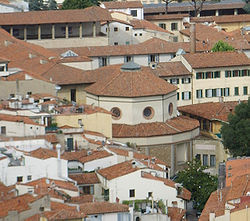
Santa Maria degli Angeli, Florence
Encyclopedia

St. Mary of the Angels Monastery (Florence)
The Monastery of St. Mary of the Angels was a monastery of the Camaldolese Order in Florence, Italy.-History:During the early part of the Renaissance, this monastery was known for the high-quality manuscripts...
in Florence
Florence
Florence is the capital city of the Italian region of Tuscany and of the province of Florence. It is the most populous city in Tuscany, with approximately 370,000 inhabitants, expanding to over 1.5 million in the metropolitan area....
, Italy
Italy
Italy , officially the Italian Republic languages]] under the European Charter for Regional or Minority Languages. In each of these, Italy's official name is as follows:;;;;;;;;), is a unitary parliamentary republic in South-Central Europe. To the north it borders France, Switzerland, Austria and...
. It belonged to the Camaldolese
Camaldolese
The Camaldolese monks and nuns are part of the Benedictine family of monastic communities which follow the way of life outlined in the Rule of St. Benedict, written in the 6th century...
order, which was a reformed branch of the Benedictines. The congregation was founded in 1012 by the hermit St. Romuald at Camaldoli
Camaldoli
Camaldoli is a frazione of the comune of Poppi, in Tuscany, Italy. It is mostly known as the ancestral seat of the Camaldolese monastic order, originated in the eponymous hermitage, which can still be visited....
, near Arezzo
Arezzo
Arezzo is a city and comune in Central Italy, capital of the province of the same name, located in Tuscany. Arezzo is about 80 km southeast of Florence, at an elevation of 296 m above sea level. In 2011 the population was about 100,000....
, hence the name. Very little of the medieval building exists today.
The monastery was a major center of studies in the early Renaissance
Renaissance
The Renaissance was a cultural movement that spanned roughly the 14th to the 17th century, beginning in Italy in the Late Middle Ages and later spreading to the rest of Europe. The term is also used more loosely to refer to the historical era, but since the changes of the Renaissance were not...
and its scriptorium
Scriptorium
Scriptorium, literally "a place for writing", is commonly used to refer to a room in medieval European monasteries devoted to the copying of manuscripts by monastic scribes...
was a noted producer of manuscripts of high quality. Many of the illustration
Illustration
An illustration is a displayed visualization form presented as a drawing, painting, photograph or other work of art that is created to elucidate or dictate sensual information by providing a visual representation graphically.- Early history :The earliest forms of illustration were prehistoric...
s from its work are found in museum collections around the world. The late High Gothic painter Lorenzo Monaco
Lorenzo Monaco
Lorenzo Monaco was an Italian painter of the late Gothic-early Renaissance age.-Biography:...
was a monk here for a time, while he tested his vocation
Vocation
A vocation , is a term for an occupation to which a person is specially drawn or for which they are suited, trained or qualified. Though now often used in non-religious contexts, the meanings of the term originated in Christianity.-Senses:...
, but ultimately he left. Nevertheless he executed a series of artworks for this monastery and other Camaldolese institutions, both during his time in the Order and afterwards.
The so-called Rotonda degli Scolari, partially built by Filippo Brunelleschi
Filippo Brunelleschi
Filippo Brunelleschi was one of the foremost architects and engineers of the Italian Renaissance. He is perhaps most famous for inventing linear perspective and designing the dome of the Florence Cathedral, but his accomplishments also included bronze artwork, architecture , mathematics,...
, is part of the complex. The church once housed a series of artworks now located elsewhere, such as the Coronation of the Virgin by Lorenzo Monaco.
The Rotunda
In 1434, Filippo BrunelleschiFilippo Brunelleschi
Filippo Brunelleschi was one of the foremost architects and engineers of the Italian Renaissance. He is perhaps most famous for inventing linear perspective and designing the dome of the Florence Cathedral, but his accomplishments also included bronze artwork, architecture , mathematics,...
was commissioned by the Medici
Medici
The House of Medici or Famiglia de' Medici was a political dynasty, banking family and later royal house that first began to gather prominence under Cosimo de' Medici in the Republic of Florence during the late 14th century. The family originated in the Mugello region of the Tuscan countryside,...
family to design an oratory
Oratory (worship)
An oratory is a Christian room for prayer, from the Latin orare, to pray.-Catholic church:In the Roman Catholic Church, an oratory is a structure other than a parish church, set aside by ecclesiastical authority for prayer and the celebration of Mass...
for the monastery. It was located at the corner of the property, along the outer wall. Though construction was rapid, it was halted due to funding problems in 1437. In 1503, the shell was given a simple wooden roof, but the structure deteriorated rapidly. The building, which was used for various purposes, was patched up and given its modern appearance in the 1930s. It was given to the university and thus its more modern name Rotonda degli Scolari ("Scholars' Rotunda").
Copies of original plans and descriptions give us a good indication of Brunelleschi’s intentions. The building was to have an octagonal, domed space at its core, surrounded by eight ancillary spaces. Though the outside - as it was restored - has little similarity with what Brunelleschi intended, on the inside one can see how some of the original spaces were arranged.

